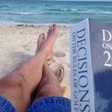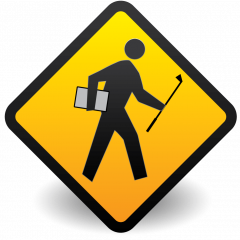-
Posts
851 -
Joined
-
Last visited
-
Days Won
2
Dormie1360 last won the day on May 23 2015
Dormie1360 had the most liked content!
About Dormie1360

- Birthday 05/11/1956
Personal Information
-
Your Location
Louisville, KY
Your Golf Game
- Index: 5.5
- Plays: Righty
Recent Profile Visitors
3,698 profile views
Dormie1360's Achievements
-
30-3f/6 Player Plays Away from Hole to Assist Partner Q.In a four-ball competition, a player purposely putts away from the hole to a position slightly farther from the hole than the spot where his partner's ball lies and on the same line to the hole as his partner's ball. The player then putts towards the hole, and the roll of his ball is helpful to his partner in determining how much his putt will break, etc. Is such a procedure permissible? A.No. Such procedure is contrary to the spirit of the game. In match play, in equity (Rule 1-4), the player is disqualified for the hole and, since his action assisted his partner's play, the partner incurs the same penalty (Rule 30-3f). In stroke play, in equity (Rule 1-4), the player incurs a penalty of two strokes and, under Rule 31-8, the partner incurs the same penalty.
-
You may lay clubs in the bunker, no penalty. Placing clubs in a bunker is not, in of itself, considered testing the sand. 13-4. Ball in Hazard; Prohibited Actions Except as provided in the Rules, before making a stroke at a ball that is in a hazard (whether a bunker or awater hazard) or that, having been lifted from a hazard, may be dropped or placed in the hazard, the player must not: a. Test the condition of the hazard or any similar hazard; b. Touch the ground in the hazard or water in the water hazard with his hand or a club; or c. Touch or move a loose impediment lying in or touching the hazard. Exceptions: 1. Provided nothing is done that constitutes testing the condition of the hazard or improves the lie of the ball, there is no penalty if the player (a) touches the ground or loose impediments in any hazard or water in awater hazard as a result of or to prevent falling, in removing an obstruction, in measuring or in marking the position of, retrieving, lifting, placing or replacing a ball under any Rule or (b) places his clubs in a hazard. 2. At any time, the player may smooth sand or soil in a hazard provided this is for the sole purpose of caring for the course and nothing is done to breach Rule 13-2 with respect to his next stroke. If a ball played from a hazard is outside the hazard after the stroke, the player may smooth sand or soil in the hazard without restriction. 3. If the player makes a stroke from a hazard and the ball comes to rest in another hazard, Rule 13-4a does not apply to any subsequent actions taken in the hazard from which the stroke was made. Note: At any time, including at address or in the backward movement for the stroke, the player may touch, with a club or otherwise, any obstruction, any construction declared by the Committee to be an integral part of the course or any grass, bush, tree or other growing thing. Penalty for Breach of Rule: Match play - Loss of hole; Stroke play - Two strokes.
-
This video was used by the USGA for a number of years in there PGA/USGA national workshops. The intent was to visually show the exception for relief under R24-2 and R25-1.
-

Posting a score for hdcp listening to music
Dormie1360 replied to David in FL's topic in Rules of Golf
I'm totally against playing music on the course. Having said that, in the OP's scenario, I'd have no problem if he wanted to post it. -
5.1a/3 is really dealing with a temp green when it mentions giving yourself par plus strokes. As Asheville mentioned 5-2g is for an unrated tee, (temporary tee). Just measure (estimate) distance from nearest rated tee, or where the old tee was, to where the temp tee is. Then use the table.
-
This is my understanding. In your first example, assuming you know the position of the ball, R25-1 applies. If the nearest point of relief is in the bunker, the ball is in the bunker and R25-1b(ii) applies. If the nearest point of relief is through the green, R25-1b(i) applies. To determine the nearest point of relief you include vertical distance. See D25-1b/25. In your second example, if the ball is embedded, it's deemed to be in the bunker. An embedded ball lies on the part of the course where it entered the ground. See D13/4
-
Just some initial comments as I've have been "off the grid" having missed the open on Sunday as well as much of what has taken place since then. I have not had a chance to look at the various threads yet. As far at 34-2 has anyone mentioned the last paragraph of D34-2/6 as well as D34-3/7 It would seem the USGA acted correctly under the rules, if you accept the fact Dustin caused his ball to move. How he was notified/not notified is certainly a valid discussion, however. I would also add, the player is protected in the sense he can not incur an additional penalty for following the referee's instruction or ruling. In Justin's case that would mean no additional penalty for playing from a wrong place. As far as having ruling "replay's" now with HD cameras and fan call ins..........I don't know. Do you want to treat players differently given the fact that most players are not televised during the competition and not subject to the same level of scrutiny, or do you want to protect the field at all costs?
-

Relief from the tee you use to mark your drop?
Dormie1360 replied to bones75's topic in Rules of Golf
I'm pretty sure this is not a re drop, A small object (tee) is not equipment as mentioned above. Talked about it in class. I believe the ball is in play, you may or may not remove tee. If you do and the ball moves, replace the ball. True story. European event, maybe the open. Player marks spot by sticking tee into ground. Drops ball which bounces and lands on tee. The ball is now teed in the rough. The player was allowed to play the teed ball. I think Chip Essig or Bryan Jones of the PGA made the ruling. When a fellow competitor questioned the ruling R & A confirmed. -
Well that is a penalty. I understood it as he was marking the ball with his putter.
- 32 replies
-
- marking ball
- putting green
-
(and 1 more)
Tagged with:
-
Not sure if this will help the OP, but the term "directly attributable" under the rules of golf is narrowly defined. There is not much leeway. In workshops we are shown various examples of what is considered directly attributable and what is not. One example shows a player accidentally dropping his coin from about six inches above the ball, causing the ball to move. This would be a penalty. (not directly attributable). The fact that the putter was being used to mark the ball, and it never left the player's hand, I think are valid considerations. In the end however, I think the ball moved because of the slip which is not normally part of the marking procedure. Just my 2 cents.
- 32 replies
-
- marking ball
- putting green
-
(and 1 more)
Tagged with:
-
Pedant alert II. The rules calls these immovable and movable artificial objects when they are not on the course.
-
Just to add, the only time you can not pickup a loose impediment is when your ball and the loose impediment lie in the same hazard. (Water hazard or bunker)
-
The Jr tournaments I work the parents must stay on the cart path and no closer than 30 yards from the players at all times. They can act as forecaddies to help search for a ball, but must leave the area when the ball is found. No advice to the player may be given.
-

Standing on Tee Marker for Aiding a Swing
Dormie1360 replied to sirhacksalot's topic in Rules of Golf
One little point. Tee markers identifying the teeing ground are deemed to be fixed. They are not obstructions until after the player makes his first stroke from the teeing ground. The only thing I can think of that might be a violation is if the tee marker moved while making his stroke. See D13-2/1.1 I'm not sure fairly taking your stance includes putting your foot on a tee marker. 13-2/1.1 Player Attempts to Take Stance Fairly But Improves Line of Play by Moving Interfering Growing Object Q.A player's ball lies under the branch of a tree. In attempting to take his stance fairly, the player improves his line of play by moving the branch with his body. Before playing, he realizes he could have taken his stance without moving the branch. He abandons his stance and the branch returns to its original position or is returned to its original position by the player. The player then approaches the ball from a different direction, takes his stance without disturbing the branch and makes his stroke. What is the ruling? A.There is no penalty. When fairly taking his stance the player is required to take his stance in the least intrusive manner that results in the minimum improvement in the position or lie of the ball, area of intended stance or swing or line of play. However, as the branch moved as a result of the player's attempt to take his stance fairly and was returned to its original position before the stroke was made, there is no penalty. Any doubt as to whether the branch returned to its original position should be resolved against the player. The same principle would apply to fixed artificial objects (e.g., a boundary stake) if the position or lie of the ball, area of intended stance or swing or line of play is improved as a result of the player's attempt to take his stance fairly but the object is returned to its original position before the player makes a stroke.







